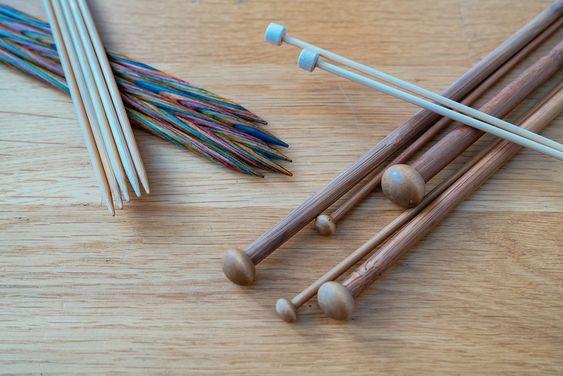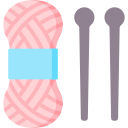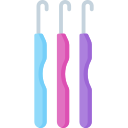Best detailed beginners guide to choosing the right knitting yarn and needles
Many people think that knitting is mainly a hobby for the elderly, but this is a widespread misunderstanding. In reality, between 2002 and 2004, the number of women knitters aged 25–35 increased by nearly 150 percent. If you want to get into knitting but don’t know where to go, here’s some advice to help you get started.
Knitting is comprised of five basic skills. The cast-on, knit stitch, and cast-off are all major steps of these techniques. These five essentials of the knitting procedure are the methods and the only way to the appropriate route of knitting. These are called the cornerstone of knitting. If you’ve mastered them, you’ll be able to call yourself a knitter. It’s that quick and simple! Just try to focus, learn and have patience!
1. Choosing the right knitting Yarn!
First and foremost, selecting the proper kind of knitting yarn is critical. It is advisable for learners to use a medium-worsted-weight yarn. This recommendation is from expert knitters and you know experience matters a lot! This is because the thinner and the thicker yarns will not get cast on easily and it will be tough for you as a beginner to get on the board with it.
Bright shades are preferable because they make it easy in seeing where you’ve knitted. Wool is also easier for beginners to work with because it is super stretchy and smooth. Fine cotton yarn and natural fiber yarns are better for experienced knitters because they are less stretchy and can be hard to knit with at first. When shopping for knitting needles, don’t be afraid to take your time.
Experts also suggest feeling the wool in your hands to assess its elasticity and content. You can refer to the ABCwools medium-sized yarn as a beginner. It is just perfect to handle all types of knitting and it will make your beginner’s route so smooth and you surely do not have to worry about the fineness!

2. Choosing the right type of needle!
Once you’ve decided on a thread, you’ll need to choose a knitting needle. They, like wool, come in a variety of materials. Experts prefer bamboo or wooden needles for newcomers because the stitches do not slip off the needles as quickly as they do for other fabrics.
Furthermore, unlike other fabrics such as plastic or metal needles, they feel secure in your hands and will not fall free. It’s also a smart idea to order several sets of knitting needles so you can play with various fabrics before you find the one you want.
The size of the knitting needles can also impact how relaxed you feel when knitting. This covers both the width and the volume. For beginners, medium sizes are usually the safest. This means that you can aim for a width of six (4mm), seven (4.5mm), or eight (8.5mm) (5mm). In terms of length, a 10-inch needle is typically a decent starting point since it is compact enough to be conveniently handled.
Longer needles can be needed when you work on larger tasks, but now as a beginner medium-sized needles are just perfect for you. Of course, there is an easy way to guarantee that you only obtain the right knitting needle for beginners. Consult a seasoned knitter!
Knitters are generally happy to chat about their favorite craft, and they should be able to steer you in the right direction and are surely going to mention the ABCwools medium-sized needle as a beginner. It is just perfect to handle all types of knitting and it will make your beginner’s route so smooth and you surely do not have to worry about the fineness
3. Cast on:
You’re about to start knitting until you’ve picked the best knitting yarn and needles. If you have any more knitting questions, the adventure continues! Create neat stitches out of stray thread. You have knitting needles and a ball of thread. You’ve decided to start knitting something. However, how can you get the thread onto the needles? Bring on the cast! Casting on is a technique for transforming loose yarn into tidy little stitches that fit snugly on your needle. It is the first step in the knitting process.

4. Knit stitch:
This basic stitch is the cornerstone of knitting. You’ve figured out how to make wool into stitches – well done! They can’t, though, just lie there like bumps on a log. They are happy to be knit! The knit stitch is the most fundamental and simple stitch. After all, it’s the craft’s name we’re studying. Master the knit stitch, and you’ll be a true knitter, my dear. Delete the right needle from the left needle.
To tighten the stitch, pull the thread tied to the ball of yarn. Knitting, like other abilities, requires time to master. You’re impossible to get the hang of it on the first try. You’re unable to catch it on the second try. What matters is that you keep trying.
5. Cast off:
Take your knitting off the needles so you can wear them proudly! You’ve completed a few rows of knitting at this stage. You should be very happy with yourself! You’ve used two sticks to make a tidy little rectangle out of a loose bundle of rope. Incredible! It is now time to take your knitting off the needles. The cast-off will get the job done. This method is good because it means the project is done! It’s all grown primed and starts to take flight off the needles and into the real world!
So yes, this was all about the beginner’s guide to knitting. You know what you have to do now. Just remember the perfect yarn and the perfect needles are the major two pillars of this procedure and you need to ace them. ABCwools have all that you are searching for! Just look at the products and you are going to love them!










